N8MR
Quest for DXCC on 160 Meters
The minimalist's approach
Loop Antenna
Season #1
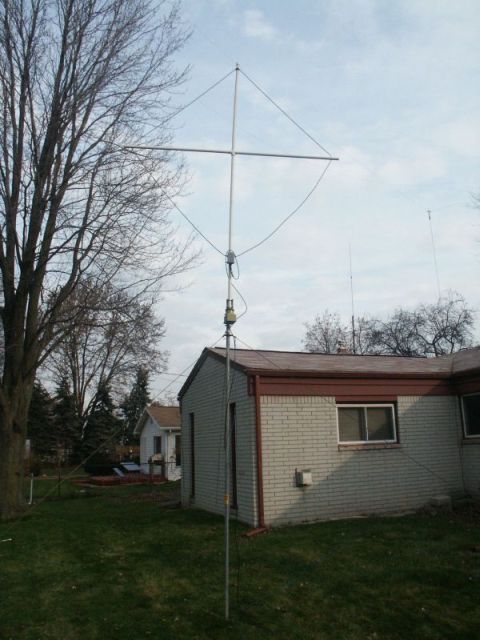
Loop antenna placement, facing north.
This is my first attempt at building a loop. After contacting my
100th DXCC entity without special receive antennas (invest in Beltone!)
I wanted to explore the possibility of having at least better receive
capabilities. Occasional electrical noise from the local power sub station
approximately 1.5 miles away has been plaguing me since I started on
topband five years ago.
In the background are the Carolina Windom 80 (vertical radiator
approximately 50 feet away) and the inverted L (vertical radiator
approximately 35 feet away).
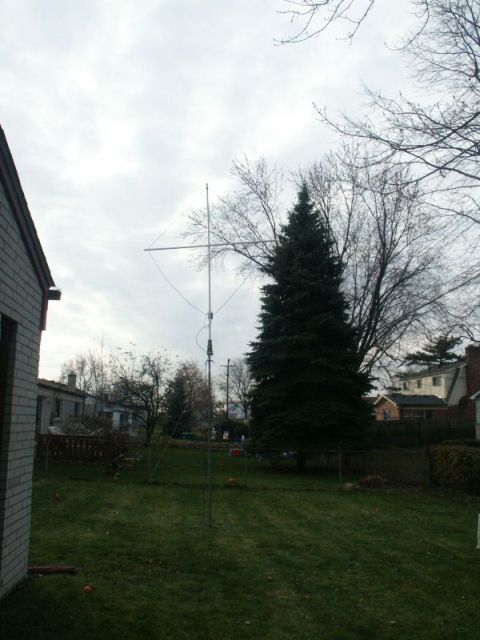
Loop antenna placement, facing south.
While I realize that this is a less-than-optimal arrangement (my entire
setup is less-than-optimal), I wanted to set up the antenna so that if it
fell down in the wind, it would not hit anything other than the ground.
Keeping the mast and antenna up are three lengths of Dacron rope that
are tied to stakes in the ground.
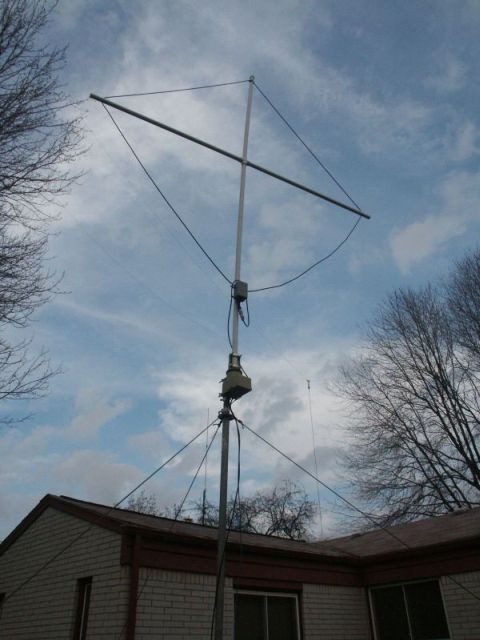
The loop.
The loop is a very common design, the likes of which can be seen all
over the web. Twenty feet of 75-ohm coax was used for the element. One
inch of the shield was removed from the exact center of the coax. This
section was then weatherproofed.
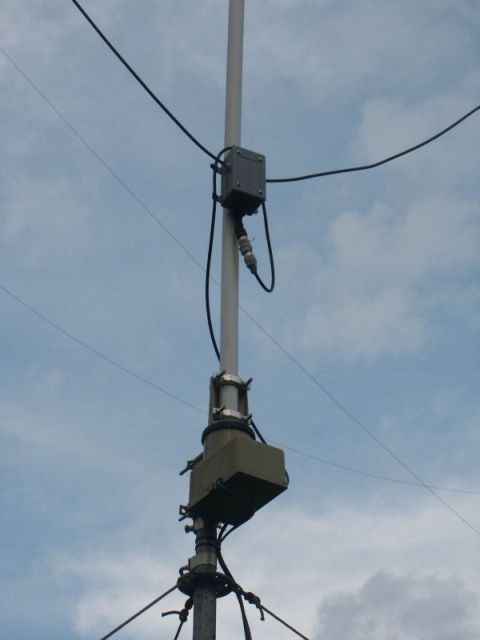
The coaxial element is supported by 1" PCV pipe. The lower mast has a
wooden dowel inside, for support. The antenna is rotated by a Channel
Master acquired from eBay (where else!). The rotator is powered by a
length of CAT5 cable, using a twisted pair per each of the three terminals.
The rotator is on top of a ten-foot mast, which was pushed approximately
six inches into the ground (this is a temporary antenna).
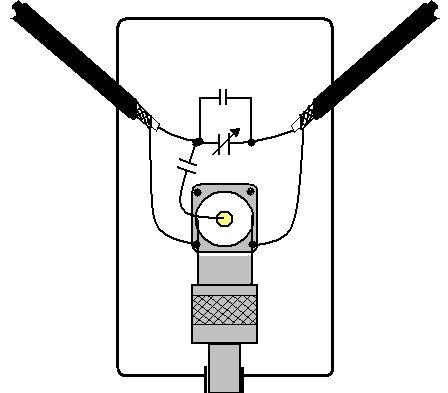
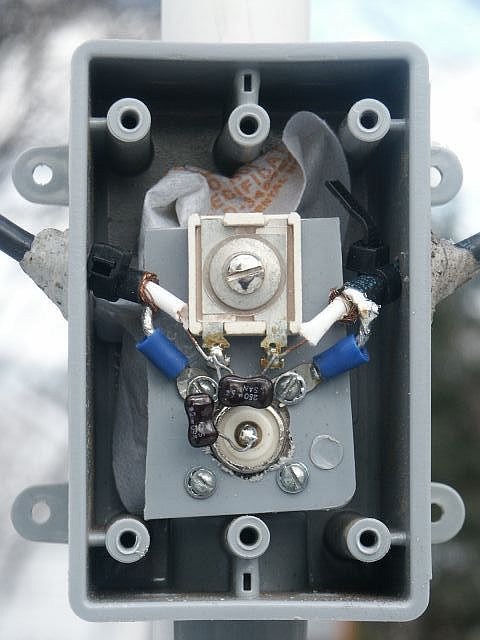
The matching network.
The matching network is inside the gray weatherproof electrical
box with a 1/2-inch opening at the bottom - just large enough for
a PL-259 to fit snuggly. The matching network consists of two fixed
capacitors and a variable capacitor. These components face the door
of the box, making access for experimentation much easier. There are
better ways of matching the loop, but this will work for now.
Strain reliefs prevent the 75-ohm coax from pulling out of the
sides. Coax seal was placed around all openings in the help prevent
water intrusion.
There is a right-angle PL259 coupler inside that allows the feedline to
hang downward. The antenna is fed with 50 feet of LMR240, which was
part of a 6-Meter off-center dipole that blew down in an October windstorm.
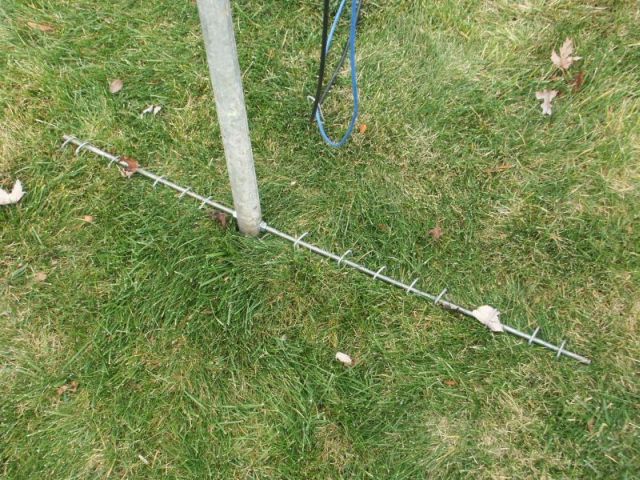
Two holes were drilled at the bottom of the mast and a three-foot length
of threaded rod was run through the hole - a lock nut put on each side of
the mast. The rod is being held in position by a number of lawn staples,
which helps prevent the mast from turning with the antenna.
I have not used the antenna enough give it a fair assessment. It definitely
helps cut down on ambient noise and much improves the signal-to-noise
ratio. Now I can hear the stations that can't hear me!
In March of 2007, I clear the yard for the summer. I removed the mast, brought
the loop to the ground, but resting vertically against the house. The
coax was still connected, just in case. It was good that I did, because on
March 19th, I worked JR7VHZ and JA7NI - my first two JAs - the
loop (as shown below) was the only antenna that could hear them.
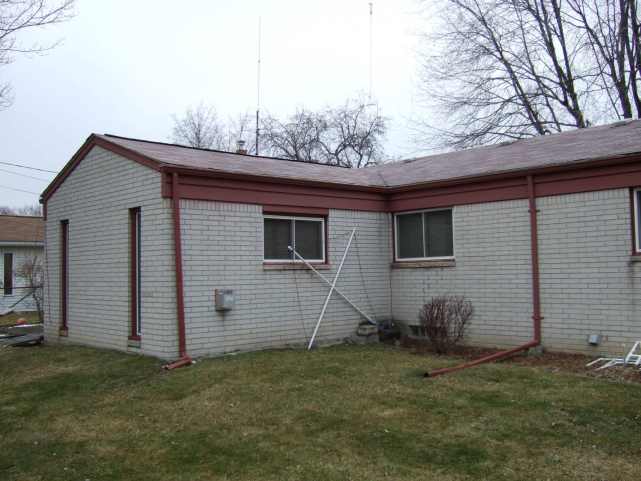
There is definitely room for improvement, especially in the matching network.
I also plan to experiment with grounding the inverted L while receiving.
While this is done inside the Yaesu FT-920, it may not be adequate.
I find the loop perfectly acceptable without preamplification, but I
sometimes use an Ameco PLF-2 preamp, which helps strengthen particularly
weak incoming signals. This is connected to the RX Ant port on the FT-920.
The loop was taken down for some anticipated matching network improvements.
The way the network was set up (per the above diagram) it was not bi-directional,
as loops normally are, but rather it received in one direction. While this may seem
advantageous, I'm sure this was an anomaly. I had intended that it would return in
the late fall...hopefully better.
Loop Antenna
Season #2
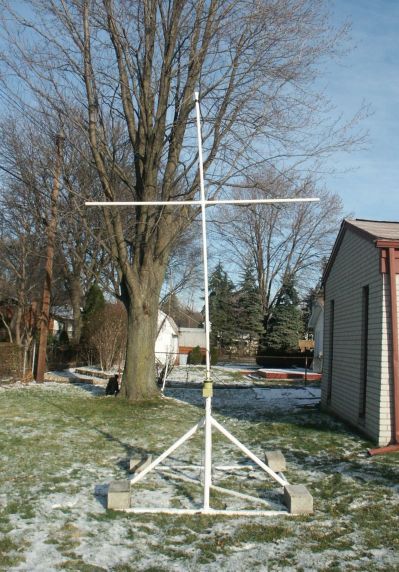
Rather than experiment with the capacitor network over the summer, The
JA QSOs I made at the end of season #1 (with the antenna on the ground)
made me wonder if the ten-foot mast from season #1 might be too high -
certainly too high for me to tweak the circuitry during the season. Many
other loop owners have had success with their antennas at eye level. So the
search was on for a mounting device that would bring the loop closer to
the ground.

My first idea was to use an outdoor umbrella stand for a base. It was
autumn and many local stores had their lawn furniture on sale. However,
the umbrella stands either not for free-standing applications, or were well
over $100 - even on sale. Idea #2 was the old standby - PVC pipe. It is
relatively inexpensive and easy to work with.

After several preliminary design considerations, I decided to let the
available PVC fixtures and their geometries dictate much of the final
design. The mast is made of several vertical pipes and fixtures held
together with PVC cement and a wooden dowel. The dowel runs the
full length of the PVC, from top to bottom, and is bolted to the PVC
mast in several places. There are only two other joints that are
bonded with PVC cement. All other areas are press fit, held
together by the weight of the loop and rotor. Cement blocks are
placed at the ends of the loop base to keep it vertical during the
windy Michigan winter season.
Preliminary, unscientific results tell me that the loop, being less than
half the height above ground as last year, shows similar receive
characteristics to last year's configuration.
Loop Antenna
Season #3
Just like the previous season, I used the PVC stand to support the
loop. The feedpoint network was left exactly the same as last year.
The results were approximately the same as season #2, however it
seemed to have lost it's ability to null out local noise sources.
This could be the result of new local noise sources. Regardless,
the loop allowed me to work over ten more new DXCC entities, taking
me to 135 worked.
I plan to rework the feedpoint of the loop to the specifications
in N6RK's Pacificon presentation.
Loop Antenna
Season #4
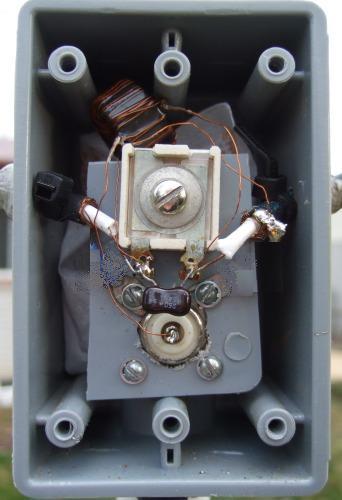
Again, I used the PVC stand to support the loop. I reworked
the feedpoint of the loop to the specifications in N6RK's Pacificon
presentation. Since I completely dismantled the original design, I
cannot do an A/B comparison. However, the loop does not appear
to have lost its ability to block out neighborhood noises or bring out
signals that are otherwise inaudible on either the inverted L or the
Carolina Windom 80. We'll see how this season fares.
Loop Antenna
Season #5 and Beyond
I continue to use the setup from Season #4 with success, trying to
keep the loop as far away from the house and other objects containing
metal. My results depend not only on propagation but also local
noise levels and directions, which vary from one year to the next.
Return to N8MR
Inverted L Antenna
"New and Improved" Feedpoint
How am I doing with this setup?
N8MR tracks all comments and questions for this page.